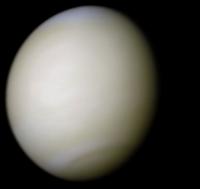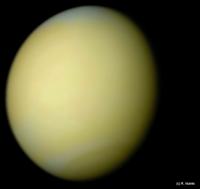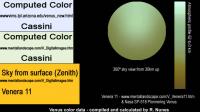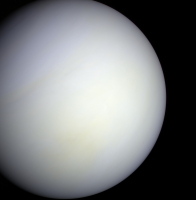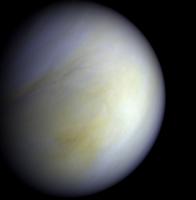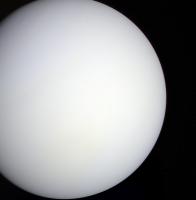Printable Version of Topic
Click here to view this topic in its original format
Unmanned Spaceflight.com _ Venus _ Global True Color View Of Venus?
Posted by: elakdawalla Aug 8 2005, 06:53 PM
I'm creating a website with views of the worlds of the solar system, to scale with each other (it'll march up and down the few orders of magnitude necessary), and I am having a terrible time finding a global view of Venus to include in it that fits the criteria I'm trying to apply. To the extent possible, I am searching for:
- Full-disk, global view
- Minimum phase angle available
- Approximate true color, as would be perceived by a human observing the globe from space
For Venus, the only global views I am finding are either based on Magellan data (radar views, nothing like what a human would see) or are colorized ultraviolet views (which greatly overemphasize the visibility of cloud patterns in the Venusian atmosphere). I've seen the lovely http://www.mentallandscape.com/Venus_Visible.htm on Don Mitchell's website -- that's the sort of thing I'm looking for, but I need a full disk. Does anybody have any suggestions? Anybody done any work with Mariner 10 or Galileo data that produces a nice, realistic view?
Posted by: BruceMoomaw Aug 8 2005, 06:58 PM
You might look into the images from Pioneer 12's spin-scan photopolarimeter -- it took visual as well as UV images of Venus (I've seen one, although it was only a half-Venus). Surely there are a few full-disk visual images of Venus in its 14-year backlog of data.
Posted by: JRehling Aug 8 2005, 09:02 PM
- Full-disk, global view
- Minimum phase angle available
- Approximate true color, as would be perceived by a human observing the globe from space
When I wanted the same thing, I once took a global image of Titan and played with the color until it was white instead of orange. Another time, I used Uranus. A blank sphere is a blank sphere...
Alternately, I might take a cylindrical map of Venus and project it onto a sphere.
If you want the genuine article, I don't think any exist, with Earth-based telescopy coming closest.
Posted by: tedstryk Aug 8 2005, 10:09 PM
Yes, but I don't think it took multiband images in the visible. Just visible and UV.
Posted by: 4th rock from the sun Aug 8 2005, 11:48 PM
My best attempts, using Mariner 10 "clear" and "blue" filter images:
These are two versions of the same image. One is processed to show a neutral white Venus, the other was based on the yellow atmosphere seen from the surface.
I've searched the internet for some Venus visible specta and found some interesting data. I'll post some images based on this data but for now my conclusion it that the planet's general color is pale-yellow, with some bright white-blue clouds (better visible in UV).
Posted by: 4th rock from the sun Aug 8 2005, 11:55 PM
Ok, here's a Venus atmospheric profile. It shows brightness and color variations from 70km up to the surface. On the right part of the image brighness variations were removed and only color changes remain.
When I have time I'll post some more Venus stuff I have around ;-)
Posted by: elakdawalla Aug 10 2005, 03:39 AM
These are exactly the kind of thing I was looking for, thank you! I'm glad that someone got around to giving this a try.
The atmospheric profile is also very cool information. I assume it could be used to make some simulated views of Venus as you descend through the clouds, just as http://www.beugungsbild.de/huygens/povray/titan_rendered.html?
Emily
Posted by: 4th rock from the sun Aug 10 2005, 12:44 PM
Check my page http://www.astrosurf.com/nunes/explor/explor_m10.htm for some more images.
But take into account that the human vision is very different from a camera. Venus clouds are VERY bright, so I don't know what a person would see on that conditions.
They can be used on your page if you like, just put a link to my page somewhere and give credit for the image processing ;-)
Yes, you could simulate going down Venus atmosphere, that's a very interesting idea.
One more thing to do when I have time....
Posted by: 4th rock from the sun Aug 10 2005, 07:10 PM
OK, here's all the data I have. This atmospheric profile updates the previous one and is a better match to the sky color visible from the surface.
Still, all the data points to a green/cyan Venusian color when seen from space!
Posted by: planet_guy Aug 25 2005, 01:17 PM
If you are interested in the surface stuff done by VIRTIS on VEX you can take a look at
http://solarsystem.dlr.de/TP/VIRTIS_en.shtml
and
http://irsps.sci.unich.it/~luciam/VEX/
The beauty of VIRTIS is that we will for the first time get global multispectral imaging from the surface of Venus over a long time period.
Posted by: algorimancer Aug 26 2005, 01:09 PM
http://solarsystem.dlr.de/TP/VIRTIS_en.shtml
and
http://irsps.sci.unich.it/~luciam/VEX/
The beauty of VIRTIS is that we will for the first time get global multispectral imaging from the surface of Venus over a long time period.
Of course, if Mars Express is any guide, we won't get to see much of the results :/
Posted by: tedstryk Aug 26 2005, 02:00 PM
http://solarsystem.dlr.de/TP/VIRTIS_en.shtml
and
http://irsps.sci.unich.it/~luciam/VEX/
The beauty of VIRTIS is that we will for the first time get global multispectral imaging from the surface of Venus over a long time period.
Great links! I wonder about something...it is thought that, despite up to 16 km/pixel resolution, atmospheric bluring will reduce resolution to 50-100 km. With this being a hyperspectral imager, are they sure that there are no holes where better might be obtained....I know the predictions, but, as they say, he who lives by the crystal ball eats glass. I also wonder if something like a spacecraft role could be used in selected areas for coverage inside of 10,000 km. I am really confused about coverage though. Some of the documents indicate that there will only be coverage of the southern hemisphere, but others indicate the best coverage will be of the northern hemisphere!
Posted by: planet_guy Aug 26 2005, 03:18 PM
well the 16km/pix are using the 'holes' ![]() the holes are in the co2 absorption, but you still have the clouds which are responsible for the blurring. of course since it has not been tried before these are only very cautious predictions. it might turn out to be somewhere between 16 and 50km/pixels
the holes are in the co2 absorption, but you still have the clouds which are responsible for the blurring. of course since it has not been tried before these are only very cautious predictions. it might turn out to be somewhere between 16 and 50km/pixels
regarding the coverage - it will be mainly for the southern hemisphere. everything in the north can be done only by stacking several orbits or (maybe) by trying some slew of the spacecraft. However, surface imaging is not the main task of VEX so this will surely not be done in the beginning of the mission
Posted by: tedstryk Aug 26 2005, 03:25 PM
regarding the coverage - it will be mainly for the southern hemisphere. everything in the north can be done only by stacking several orbits or (maybe) by trying some slew of the spacecraft. However, surface imaging is not the main task of VEX so this will surely not be done in the beginning of the mission
Sounds like an extended mission task. 16 km was the resolution/pixel, 50-100 was the estimated realistic resolution, thanks to the atmosphere. I am just hoping that the predictions don't hold up
Posted by: planet_guy Aug 26 2005, 03:28 PM
trust me.. I'm also hoping the predictions are wrong ![]()
Posted by: JRehling Aug 26 2005, 03:50 PM
I'm worried more about the spectral resolution -- All the Galileo image really shows is that areas of higher altitude are cooler, and if all we get out of this is thermal information at >10 km resolution, it'll be of very little interest.
Even with excellent data, spectral resolution has a tough time converting into mineralogy (note TES @ Mars, and the very vague assessments of the non icy compositions of the Galileans). In the case of Venus, we'll have so much spectral interference from numerous species (some unknown!) not to mention thermal noise, really the best I hope for is that we get a good cumulative, length-of-mission differentiation between planitia, tessera, fresh lava flows, and the radar-bright areas at high altitudes. Anything evidentiary about mineralogy between those four unit types would be great, and the recognition of any units that show up in IR but not in radar would be a godsend.
As far as eye candy goes, the best we could dream of would be to get low res data that could be used to "color" the radar maps illustratively or realistically.
One good subcloud aerobot with a camera would take a much better whack at this, with an easy time of making visible light spectra on the surface unit level, if not decameter level. Hopefully soon...
Posted by: BruceMoomaw Aug 29 2005, 12:39 AM
I promised fully 2 months back to dig up whatever stuff I had on the possible ability of VIRTIS to map surface composition, and I'm putting up that entry now back on the "Venus Express" thread.
Posted by: Tayfun Öner Dec 4 2005, 06:41 PM
It is unbelievable that Venus is the nearest planet and we still don't have a single global true color image of it. Galileo could have done it but did not, I don't know if Cassini could do it because of technical issues. It may or not have a scientific value but it should be done. I hope Venus Express has a suitable camera and filters for this job. (Pluto not yet explored, Venus not yet explored in true color).
Posted by: JRehling Dec 5 2005, 02:03 AM
We don't have many great pictures of the far side of the Moon in true color, and not very many near-full phase pictures of the Earth in true color!
As I mentioned earlier, there are some pretty good pictures of Venus taken from Earth, in which case, it is never a full Venus, but at least we can start to imagine the real deal!
FWIW, Mercury is the third-nearest planet, and the impoverishment of good imagery there in anything approximating true color is astonishing. Even FROM Earth!
Posted by: DonPMitchell May 5 2006, 08:49 PM
There is a spectral albedo for Venus. That can be turned into XYZ, via the CIE tables. Then convert that into Standard RGB ("sRGB"), which is a set of phosphor chromas that the computer industry and the HDTV people all more or less agree on. It has a gamma of 2.2.
Here's a set of planet colors, with brightnesses proportional to the total albedo:http://www.deviantart.com/view/28476932/
Posted by: JRehling Oct 12 2007, 10:32 PM
- Full-disk, global view
- Minimum phase angle available
- Approximate true color, as would be perceived by a human observing the globe from space
[resurrecting a long-dead thread]
The lack of this has always bothered me. Messenger took an image of an almost full Venus, but cropped two edges, and only the plain filter image was made public.
Thanks to the blandness of Venus, it's not too hard to patch that image up. I used its own north end to fill in the cropped-out south and used a Titan image (appropriately tweaked from orange to BW) to sub in the cropped-out west. Then I took an amateur's earth-based image to find the right color balance. And... voila. A little bit of fiction is involved, but I think it fits the above criteria, that said.
Posted by: scalbers Oct 12 2007, 10:52 PM
Well, I guess this wouldn't be true color, yet the past two issues of Sky and Telescope magazine have had some nice Venus shots from Earth. These show some cloud features utilizing ultraviolet filters.
Posted by: Gladstoner Jan 4 2008, 09:05 AM
.
Posted by: 4th rock from the sun Dec 29 2008, 01:08 PM
Hi all,
I've updated my webpage with some Venus Express images processed in approximate real color.
The images seem to show the Venusian atmosphere extending from the limb with a bluish color. The general tone of the planet is yellowish, in accordance to similar processing I've done with Mariner 10 images, available on this site. The brightest clouds are bluish, given that they reflect strongly on the UV parts of the spectrum.
RGB channels were computed from NIR1, VIS and UV images using the following averages:
Red = 0.3 x NIR1 + 0.7 x VIS = 0.3 x 965 + 0.7 x 513 = 649
Green = VIS = 513
Blue = 0.5 x VIS + 0.5 x UV = 0.5 x 513 + 0.5 x 365 = 439
Here's one image, you can see more at http://www.astrosurf.com/nunes/explor/explor_vex.htm
Posted by: ugordan Jun 1 2009, 06:48 PM
I've been messing around with the MESSENGER calibrated data and even though it's not a complete global view, I thought I'd share it here. From the filter choice standpoint, it's the closest we get to a RGB image for the time being. I already posted a few of those in the MESSENGER PDS threads, but those were quick-n-dirty versions.
Below is the familiar inbound view by the wide-angle camera, but this time I approached it somewhat differently. Instead of the typical E/D/C "red/green/blue" filter combo, I used E/D/F. Even though the "F" filter is labeled as violet, at 430 nm central wavelength it's actually much closer to the peak sensitivity of the blue light-sensitive cones in the human eye (437 nm). The "C" filter is shifted way too much toward green at 480 nm and also much more narrowband. Venus composites http://farm4.static.flickr.com/3317/3447783055_7201387b94_o.png as a result fail to capture the bright clouds that reflect strongly in the UV, while the "F" filter does exactly that while still being inside human vision boundaries, i.e. not being UV.
I used the ground calibration tables when calibrating the data as the inflight-derived results look inconsistent across filters to me. Next, I took the central filter wavelengths and compared them to the sRGB colospace central wavelengths. I calculated approximate channel mixes to bring the "average" wavelength in all 3 RGB channels to sRGB, this is what I used:
red = 0.72*E + 0.28*D
grn = 0.93*D + 0.07*F
blu = 0.73*F + 0.27*D
Finally, I boosted saturation by +15 to compensate for a slight loss of saturation by above mixing.
Here is the resulting composite:
It looks as it's in the same ballpark as some other versions here. This one is not gamma-corrected because absolutely all contrast would be washed out and you'd end up with a shiny white billiard ball.
Here's a high-pass enhancement to bring the clouds out a bit:
Posted by: Stu Jun 1 2009, 08:48 PM
Absolutely beautiful images, thanks for posting them here. Hope you won't mind me using them in my talks? That second one is just sublime.
Posted by: ugordan Jun 1 2009, 09:08 PM
Sure, no problem at all, Stu. Glad you like them.
Posted by: 4th rock from the sun Jun 2 2009, 09:55 AM
...This one is not gamma-corrected because absolutely all contrast would be washed out and you'd end up with a shiny white billiard ball.
....
Nice results. I think that the channel mixing to average center wavelenght works very very well and can be used with almost any filter set. I'm not shure it saturation suffers that much, because that would have more to do with each filter bandwidth. Nevertheless, results are consistent. I think that you could include a gamma corrected version, because that would show exactly why the details are dificult to see at the telescope. It would also be closer to what we might see if in orbit of the planet.
Posted by: ugordan Jun 2 2009, 10:15 AM
Well, you asked for it:
This was done on the 8 bit PNG above, not the 16 bit one I worked with as I'm at work now, but this only induces a slightly higher noise near the terminator. I continue to be amazed at just how sharply defined the planet's limb is. It really looks like someone put a solid ball in space - no limb brightening or other Rayleigh scattering effects.
Posted by: Stu Jun 2 2009, 10:35 AM
Wow, there really would be b****r all to see if you went there, wouldn't there? Makes Uranus look positively psychedelic! ![]()
Posted by: ugordan Jun 2 2009, 10:43 AM
Yep, and every time I see a montage of all solar system planets with Venus depicted by the brown-red Magellan surface globe, I die a little inside...
*cough*Photojournal*cough*
Posted by: tedstryk Jun 4 2009, 09:42 PM
*cough*Photojournal*cough*
The coloration is based on Venera images from the surface, not the cloudtops. Granted, the coloration is due to the filtering of light in the atmosphere, but if we are going to be anal about coloring it like we would see it from space, then the clould should be covering it as well. I will add that the color is still a bit red, mostly owing to the fact that the Venera images have been better calibrated since the Magellan mission ended.
Posted by: ngunn Jun 4 2009, 10:18 PM
Late night trivia I know, but I'm anatomical about this too. If the viewpoint is out in space then indeed the image should show what would be visible from there - if the aim of the image is to inform the public directly. Other kinds of image useful for scientific purposes that strip away atmospheres, represent invisible frequencies using visble colours, stretch contrast, or vertical scale, should be accompanied by health warnings if posted on public websites. The latest VIMS paper is exemplary. The images come with an explanation of what the colours stand for in each of the two ways the data are represented. It's clear that they do not mean "this is what it would look like". Making an artificially coloured radar map serve as the 'appearance' of Venus is a travesty. (Don't look too closely, it may also be vertically exaggerated.)
Posted by: Stu Jun 4 2009, 11:21 PM
Every time - EVERY time - I start work on a new kids book about space I have a fight with an editor who is adamant that they should use garish false colour images of the planets instead of more accurate ones. That bloody psychedelic Voyager pic of Saturn is one I have to argue against, as is the UV pic of detail in venus' clouds. Oh. and they just lurve the migraine-inducing false colour Voyager shots of Uranus too...
Posted by: tedstryk Jun 5 2009, 10:21 AM
I agree with the false color Voyager shots. However, if you are going to show Venus the way it looks from space, you shouldn't show it from the surface at all. Using the rough apparent color of the surface to a viewer under the clouds who can actually see the surface should not be put in the same league with this.
Posted by: Juramike Jun 5 2009, 11:08 AM
Personally, I don't like the wavelength limitations of visible light. Hyperspectal imaging, false color imaging, topgraphical coloration, mineral maps based on diagnostic bands - all these things make comparisons and contrasting of features easier (and pretty!).
But I totally agree with the points above: if you are going to show false color or enhanced images, it is important to put a warning lable that they are false color views. And if you are going to show a set of comparison images of planets, they should be all treated similar. If you strip the atmosphere and clouds off one of the terrestrial planets (like Venus), you need to do it for the other similar planets.
If you are only going to show the upper atmospheric structure of Venus, Earth's also needs to be shown for a comparison (but obviously not using the the same technique). [How are they similar? How are they different? Why?]
I always thought the perfect kids book would show a topographic representation of the terrestrial planets for comparison:
["Gee, without water, Earth still has ocean basins and continents....how come the other worlds don't have this? And what's going on with that ridge going down the Atlantic basin? How come Mars has those deep holes? Why are parts of the Moon so smooth?"]
Posted by: tedstryk Jun 5 2009, 01:51 PM
I would say that there is a difference between false color imaging that shows, say, infrared wavelengths, so that the colors contain real information that can't be conveyed in a "true" color image and images that are simply colorized to look "cool." Juramike, I fully agree on the visible light issue. Our eyes evolved for our purposes here on earth, but there is so much to be gained from adding non-visible wavelengths. That is why I really prefer to call , for example, a color-shifted Voyager image G-V-UV color instead of "false" color. It isn't entirely false, in the sense that the colors really do mean something.
Posted by: Stu Jun 5 2009, 01:58 PM
The problem I encounter is that editors want to use a garish false colour pic without explaining that it IS false colour, which would obviously lead to young readers being led to believe that Saturn really is decorated with poster paint blue, red and green clouds. I once had to fight - not literally! - with an editor to have a false colour view of Victoria Crater (you know, one of the "everything looks blue" images) removed and replaced with a natural colour one, because they wouldn't give me room to explain the nature of the pic. That would have meant a big header saying "Mars - the Red Planet" with a picture of a kingfisher-blue cliff face beneath it... ![]()
Posted by: tedstryk Jun 5 2009, 04:41 PM
I agree, but I still think that showing the Venusian surface as it would appear in the light that filters through the atmosphere much less "deceptive" than the examples you use, especially when the image is a radar image, so it isn't going to be visually realistic no matter how you portray it.
Posted by: Stu Jun 5 2009, 05:40 PM
It's this image I have had to fight to stop editors using...
http://www.pietro.org/images/VenusByPioneer.jpg
![]()
Posted by: tedstryk Jun 5 2009, 05:44 PM
Not only is the color bad, but that is a Mariner 10 image.
Posted by: Stu Jun 5 2009, 05:52 PM
Okay, but you get the idea, right? Editors can be hard to convince; they're - understandably - looking for visual impact, something to grab the attention of young readers, and once they've found a "wow" pic to use (don't know how they managed before Google!) you almost have to wrestle it out of their clutching hands...
Posted by: brellis Jun 5 2009, 08:42 PM
When's Google Venus gonna be up and running? ![]()
Posted by: tedstryk Jun 6 2009, 10:16 AM
Yes, I get the idea. However, to me, the fact that a lot of Magellan imagery is shown with 20x vertical exaggeration is in that category, but using Venera-based colorization isn't.
Posted by: scalbers Oct 15 2010, 09:12 PM
Is this web page with a Venus image showing some real data or an artistic work?
http://rocksfromspace.open.ac.uk/Venus.htm
If I can find a "full" Venus image I can try to see what it looks like with Science On A Sphere.
Thanks,
Steve
Posted by: machi Oct 15 2010, 09:26 PM
It looks like old UV image from Pioneer Venus.
I think this one:
http://www.nasaimages.org/luna/servlet/detail/nasaNAS~20~20~120205~226904:Pioneering-Venus
Posted by: CJSF Oct 16 2010, 12:26 AM
http://rocksfromspace.open.ac.uk/Venus.htm
If I can find a "full" Venus image I can try to see what it looks like with Science On A Sphere.
Thanks,
Steve
I agree- that is a UV image of Venus. True color images look pretty much like a billiard ball. See http://www.unmannedspaceflight.com/lofiversion/index.php/t1243.html for more information.
CJSF
Posted by: 4th rock from the sun Oct 16 2010, 03:33 PM
Here's my Pioneer Venus image galery: http://www.astrosurf.com/nunes/explor/explor_pvenus.htm
Most of the images I had acess to were very degraded and from old magazines and books, but at least they are organized by date.
I think most of the images were taken with the Near UV (365nm?) filter, but the camera was capable of operating on other wavelengths.
Posted by: Phil Stooke Oct 16 2010, 04:18 PM
Nice set of pictures! The last image on your page, the one with the question mark, looks like it is probably from Mariner 10.
Phil
Posted by: scalbers Oct 16 2010, 05:53 PM
CJSF
Right, though perhaps it might be interesting to try colorizing the Pioneer UV images by using information from missions like Venus Express and MESSENGER? Perhaps some subtle color might be visible and would give us a reasonable approximation of a "global true color" image.
Posted by: ugordan Oct 16 2010, 06:01 PM
It's not merely about color, it's about contrast. And quite frankly, in visible wavelengths there just isn't any appreciable contrast.
Posted by: scalbers Oct 16 2010, 06:06 PM
Yes indeed the actual contrast is much more subtle than in the Pioneer UV images. For example Ricardo Nune's images show Venus Express processed into approximate RGB, showing rather subtle hues. This procedure might be applied to the Pioneer UV images perhaps, even though these are monochromatic. It's kind of interesting to me to consider whether the human eye can perceive at least some faint contrast/color with Venus. Perhaps it relates to violet light sensitivity that can vary between individuals.
I haven't found too many spectra of Venus or its cloud features. Here is a VIMS spectrum of Venus for reference, though I'm unsure of the field of view.
http://vims.artov.rm.cnr.it/data/res-ven.html
More discussion is here:
http://www.unmannedspaceflight.com/index.php?showtopic=1399&st=0&p=20237&hl=420nm&#entry20237
Here is a book excerpt showing illustrations of visual observations of Venus' clouds, so the contrast is detectable to some, seen right here from planet Earth:
http://books.google.com/books?id=LqwUuMYIEtkC&pg=PA237&lpg=PA237&dq=venus+cloud+feature+telescope&source=bl&ots=YFHWcgSPYw&sig=xMnTFzL2YRLTuXgufMKbm_IHd6g&hl=en&ei=lPS5TOuMKcP6lwep6IDFDA&sa=X&oi=book_result&ct=result&resnum=10&ved=0CDoQ6AEwCQ#v=onepage&q=venus%20cloud%20feature%20telescope&f=false
Posted by: EDG Oct 17 2010, 12:52 AM
Has anyone actually tried to make a true-colour map of Venus' surface directly from the Magellan radar data? I know there's separate topo data available but IIRC that was pretty low resolution - is it possible to extract data directly from the SAR images (e.g. pulse travel time) to get higher-res altimetry? And then make a global topography map from that, coloured as if we were looking at basalts?
Posted by: nprev Oct 17 2010, 01:37 AM
I don't know how you could ever make a 'true color' map of the surface of Venus. We've only seen a very few small spots from the Venera probes--not enough to generalize about the entire planet--and there's no way to extract color from radar data. If that wasn't enough, lighting conditions, surface compositions, etc. undoubtedly do vary for a variety of reasons, so even if we could somehow obtain visible-light surface images of the entire surface that wouldn't necessarily correspond with what the human eye would actually see.
Even doing this for Mars is a formidable challenge; there's inevitably some degree of interpolation/assumption involved, as our resident imagemages will surely attest.
Posted by: 4th rock from the sun Oct 17 2010, 01:26 PM
My personal experience is positive. I can see "something" on Venus through a telescope. My best description would be of a white crescent with some brighter parts. Those bright spots look slightly fluorescent. But it's not obvious, the contrast is very subtle and there's no color at all. Like looking at snow deposited over snow.
I think it has to do with the Rod cells on our eyes. Those are most sensitive to wavelengths of light around 498 nm and are responsable for the Purkinje effect http://en.wikipedia.org/wiki/Purkinje_effect. Perhaps something like that works for Venus.
Posted by: EDG Oct 17 2010, 07:02 PM
Well, it'd definitely be "simulated true colour". I was thinking more "this is what the surface could look like, assuming basaltic composition". I know that bright (reflective) radar patches aren't necessarily bright in visible light, for example - they're just rough surface (unless they're on mountaintops IIRC, in which case they might actually be pyrite deposits?).
Someone could take a small feature on Venus (e.g. a dome or crater) and translate the radar bright/dark into visible (using appropriate rules like "radar bright = rough surface, radar dark = smooth surface") that would be nice. I guess it's more a space art/visualisation thing than anything "scientific", but it'd be nice to be able to look at a view of Venus and say "that's what we might see if we looked at this feature in visible light".
Posted by: tedstryk Oct 17 2010, 07:45 PM
How on earth would that be any less simulated than one based on the Venera pictures?
Posted by: scalbers Oct 17 2010, 08:59 PM
I think it has to do with the Rod cells on our eyes. Those are most sensitive to wavelengths of light around 498 nm and are responsable for the Purkinje effect http://en.wikipedia.org/wiki/Purkinje_effect</a>. Perhaps something like that works for Venus.
Pretty neat that you've been able to see such features. It seems to me Venus is bright enough so it would work more with cones rather than rods.
While color may not show up with a small crescent, I can speculate that if one can see features from Earth, then orbiting in a spacecraft it would look large enough to have a chance at seeing a slight hue.
Posted by: EDG Oct 17 2010, 09:20 PM
I dunno, I didn't say it would be
Posted by: JohnVV Oct 18 2010, 02:53 AM
true color - not possible
now a "better" than that old red/orange and yellow/white
http://photojournal.jpl.nasa.gov/jpegMod/PIA00481_modest.jpg
http://photojournal.jpl.nasa.gov/jpegMod/PIA00104_modest.jpg
the color i settled on
http://www.unmannedspaceflight.com/index.php?s=&showtopic=1410&view=findpost&p=164503
http://www.imagebam.com/image/f71904102661359 http://www.imagebam.com/image/439061102661366 http://www.imagebam.com/image/15fb90102661386
now as to clouds
They change SO fast that there is no "real" up to date data
-- artist concept --
http://www.imagebam.com/image/a5629c102662005 http://www.imagebam.com/image/d7e88189421988
that i use a 100% artistic map for it
a link to a artistic thread
http://www.shatters.net/forum/viewtopic.php?f=5&t=16019
( the last post is the above image)
the color is adjusted so that some of the clouds can be seen and it looks like "bright smog"
basically it is darker than if "you" were in orbit looking down at it
Posted by: scalbers Mar 25 2017, 02:55 PM
Here's a set of planet colors, with brightnesses proportional to the total albedo:http://www.deviantart.com/view/28476932/
I came across http://mentallandscape.com/Venus_Visible.htm, so the RGB values could indeed be calculated for Venus (sky) as seen from space and from the Venusian surface.
It's interesting that Rayleigh scattering from CO2 is somewhat competitive with the scattering of light by the clouds. Only 2.5% absorption by clouds as well in http://onlinelibrary.wiley.com/doi/10.1029/JA085iA13p08167/full.
Posted by: JRehling Mar 26 2017, 10:12 PM
A long-dormant thread awakens!
I think one thing is clear: If a person orbiting Venus looked down at the clouds, the sensation would probably be pain. It hurts to look at white snow on a sunny day and Venus is similar but twice as bright. It would have an overwhelming brilliance that would require some sort of filtering – sunglasses – for a person to have a chance at perceiving it without saturation of the cones. And once you're filtering, "real" goes out the window.
We could employ neutral filters that damp down every wavelength equally, but the psychophysical research says that the degree of damping affects the perceived color (i.e., the Purkinje Effect). So now we're once again into the realm of the subjective.
Over the past few months, I've looked at Venus more often than any other year. Sometimes at night, but often in the day, seeing its gibbous and crescent forms in a blue daytime sky, including yesterday when I saw it at inferior conjunction – north of the Sun, appearing neither in the evening nor morning, with its southern crescent lit. I've looked at it at least ten times since early December. In the daytime blue sky, Venus looks white – the same white as a front lit cumulus cloud. In a dark sky, I have felt like there are hints of color, but they're right at the threshold of perceptibility and, moreover, the atmospheric conditions on Earth may introduce a bigger color signal than whatever is on Venus itself.
Here's an interesting look at the empirical facts, from Venus Express:
https://www.researchgate.net/profile/Santiago_Perez-Hoyos2/publication/234520225/figure/fig3/AS:299990997061643@1448534835765/Figure-3-Venus-reflected-and-emitted-spectrum-The-top-panel-shows-the-spectrum-in.png
The top panel shows that Venus' spectrum is sloped very slightly towards the blue over most of the visible range, but then it begins to fall off steeply in reflectance into the violet. In essence, Venus is not spectrally neutral but the short, steep decline in violet is offset by the long, gradual excess blue relative to the longer wavelengths. But this empirical data is only as meaningful as our ability to translate it in terms of perception and there we get into the murkiness of human color vision, phase angle, etc.
In summary, Venus appears almost painfully, brilliantly white. In conditions when lenses, mirrors, or filters decrease the intensity, it's still very close to white with an excess of blue and a deficit of violet perhaps canceling out, but what is perceived will depend upon context.
Posted by: JRehling Jun 11 2017, 05:59 PM
This video not only has a nice overview of the Akatsuki mission, but also has a nice global view of Venus at around 1:20. I have no idea what produced this image, but it looks right to me. Quite similar to the view I made by taking my own photos of a gibbous Venus, projecting them onto a map, filling in the gaps assuming perfect symmetry, and then projecting that map onto a sphere for the "full" Venus view.
https://www.youtube.com/watch?v=NP1q_Kl-y74
Posted by: JohnVV Jun 11 2017, 06:32 PM
some guesses
at 1:15 i would say venus express
at 1:28 that is the orange megllian radar data
at 1:31 pioneer venus
Posted by: JRehling Jun 26 2017, 05:20 AM
This may be about as good as you can get from Earth for a true-color photo of Venus in a full phase. Taken by amateur Arnaud van Kranenburg back in 2006 as part of the amateur campaign to assist Venus Express. The leftmost image in the second row is RGB, and seems close to true color, and Venus is 98% full. If you wanted to "convert" this to 100% full, it would do pretty well to copy the right limb and reflect it over the left side, which features the almost-full terminator.
http://sci.esa.int/venus-express/40018-vaop-images/
What's lacking is resolution – Venus was on the far side of the Sun and the instrument was only a 9.25-inch telescope. However, since there is likely next to no discernible detail to be had at higher resolution, it's not too hard to upscale + blur (+ deconvolve) this into a very good simulation of what the same view at higher resolutions would resemble.
Powered by Invision Power Board (http://www.invisionboard.com)
© Invision Power Services (http://www.invisionpower.com)

